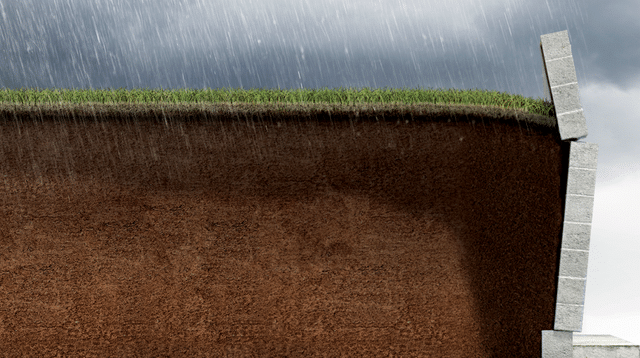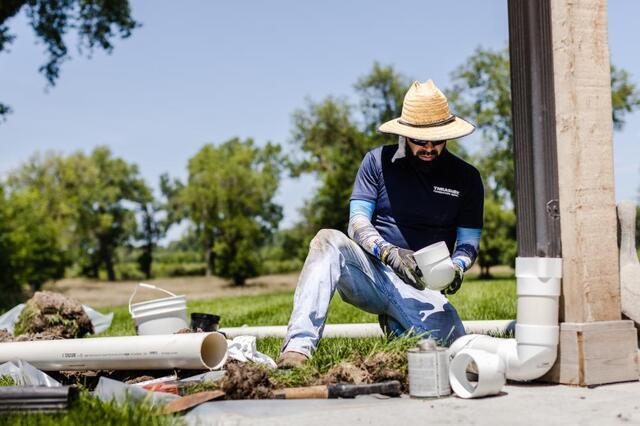Why Your Basement Leaks & 5 Easy Ways To Fix It

Ah, an infamous basement leak. We feel your pain, really. From water damage to mold growth, basement leaks can be a real headache. In this blog, we'll uncover the common reasons basements leak and the easy ways you can fix them.
What causes basement leaks?
To prevent basement leaks, you first have to understand them. Two common reasons basements leak are hydrostatic pressure and the clay bowl effect.
1. Hydrostatic pressure
One of the primary causes of basement leaks is hydrostatic pressure. It's a natural force exerted by groundwater against the foundation walls and floor of your basement. As the soil surrounding your home becomes saturated with rainwater, the excess water creates pressure against your foundation. Over time, this pressure can push water through any cracks or gaps in the foundation, leading to leaks.

1. Clay bowl effect
When your house was being built, builders dug a big hole and excavated the soil. Then, they poured your foundation and put some of the soil back to fill in the gaps between your foundation walls and the earth. This process is referred to as backfilling.
In most cases, the soil used during backfilling has different characteristics than the original soil. It's looser and more permeable. However, the undisturbed soil deeper in the ground tends to be more compact and clay-like. This difference in soil creates what's known as the clay bowl effect.

When rainwater or groundwater reaches the looser, backfilled soil, it starts to accumulate around your foundation, much like a bowl filling with water. This trapped water can exert hydrostatic pressure on the foundation walls seeping through any openings and causing leaks.
How to find the source of the basement leak
If your basement is leaking, the first step is to identify the water's entry point. Common culprits include the floor joint, walls, windows, and plumbing fixtures. To trace the leak, you can use a moisture meter or conduct a visual inspection. Keep an eye out for water stains, mold, or musty odors - these are key indicators. Here are a few points to assist you in finding the source.
1. Flooding basement floor joint
If your basement is leaking through the basement floor joint, you'll see visual signs such as a wet floor, cracks along the floor, water stains, mold, bubbling or peeling paint, and efflorescence. Some of these indications might develop gradually as water seeps in over a period of time, but they might become more apparent following heavy rain.
2. Basement wall leaks
Another potential leak source can be your basement walls. Although these walls play a pivotal role in supporting your home's foundation, improperly waterproofed walls can become susceptible to water infiltration. Common triggers for basement wall leaks include:
- Cracks: Settlement or frequent ground movement can create stress-induced cracks in basement walls.
- Pipe penetrations: Improperly sealed pipe passageways can serve as an entry point for water.
- Gaps in grout: Eroded grout lines in masonry walls establish pathways for water seepage.
Look for visible indicators like cracks along the walls, peeling paint, crumbling mortar, rust, and efflorescence if you suspect a basement wall leak.

3. Basement window flooding
Basement windows can flood due to improper drainage in window wells, poor foundation grading, and faulty window well sealing.
- Inadequate draining in window wells: Ill-designed or poorly maintained window wells can collect water during heavy rainfall or snowmelt.
- Flawed grading: Bad grading around your foundation can lead to rainwater and melting snow pooling in your window wells.
- Poor window well sealing: Inadequate seals between the frame and walls can allow water to enter during rainy conditions.
Signs pointing to window issues include puddles, rotting and warping wood frames, rusted metal window frames, drafts, air leaks, and condensation on the window.
4. Plumbing issues
At times, basement leaks may stem from plumbing issues, such as failing water heaters or damaged washing machine hoses.
- Failing water heaters: A water heater typically lasts 6-12 years, but system leaks can result in water pooling on your basement floor.
- Broken washing machine hoses: Worn-out or damaged washing machine hoses can also lead to leaks.
If this is the case, you'll likely notice appliance malfunction before extensive water damage occurs. In these instances, you should contact a plumber.

What to do if your basement is leaking
Basement leaks can be frustrating, but taking action can help prevent further damage. After identifying the source of the link, here are a few things to do to prevent more leaks before the next rain.
1. Check gutter and downspouts
Clogged gutters and downspouts can cause water to overflow, pool around your foundation walls, and enter your home. If you notice your gutters overflowing when it's raining, it probably needs a good clean. Remove all leaves and debris to ensure water is properly channeled away from your home.
2. Seal cracks in the foundation
Inspect the exterior and interior of your home's foundation for any cracks or gaps. An interior sealant might work if the cracks are small. If you find a severe crack, calling a professional to seal it would be a better investment.

3. Fix grading issues
Make sure the grading around your home is sloping away from your foundation. Poor grading can cause water to pool near the basement walls and increase the risk of leaks. To fix this, you can add soil around the foundation.
4. Clean window wells
Like gutters, window wells can get clogged with debris and not be able to properly drain. Clean out any leaves, dirt, or other obstructions to allow water to freely flow and drain from the window wells.
5. Contact a basement waterproofing expert
If you're unable to identify or address the source of the leak on your own, it's best to contact a reputable basement waterproofing company. They'll assess the water damage and recommend appropriate solutions to permanently fix the issue.

If you're experiencing these issues in our service area, our team at Thrasher Foundation Repair is here to help. With our expertise in basement waterproofing, we'll ensure your basement stays dry and cozy. Contact us today by starting a chat in the bottom right corner, filling out this form, or calling us at 1-800-827-0702
Article Categories:



